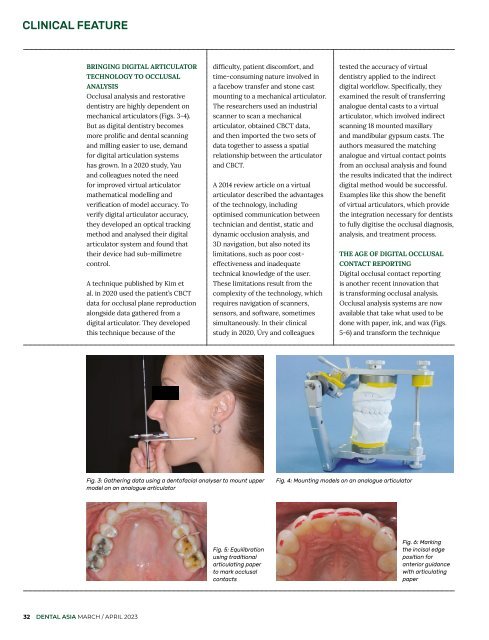Dental Asia March/April 2023
For more than two decades, Dental Asia is the premium journal in linking dental innovators and manufacturers to its rightful audience. We devote ourselves in showcasing the latest dental technology and share evidence-based clinical philosophies to serve as an educational platform to dental professionals. Our combined portfolio of print and digital media also allows us to reach a wider market and secure our position as the leading dental media in the Asia Pacific region while facilitating global interactions among our readers.
For more than two decades, Dental Asia is the premium journal in linking dental innovators
and manufacturers to its rightful audience. We devote ourselves in showcasing the latest dental technology and share evidence-based clinical philosophies to serve as an educational platform to dental professionals. Our combined portfolio of print and digital media also allows us to reach a wider market and secure our position as the leading dental media in the Asia Pacific region while facilitating global interactions among our readers.
You also want an ePaper? Increase the reach of your titles
YUMPU automatically turns print PDFs into web optimized ePapers that Google loves.
CLINICAL FEATURE<br />
BRINGING DIGITAL ARTICULATOR<br />
TECHNOLOGY TO OCCLUSAL<br />
ANALYSIS<br />
Occlusal analysis and restorative<br />
dentistry are highly dependent on<br />
mechanical articulators (Figs. 3-4).<br />
But as digital dentistry becomes<br />
more prolific and dental scanning<br />
and milling easier to use, demand<br />
for digital articulation systems<br />
has grown. In a 2020 study, Yau<br />
and colleagues noted the need<br />
for improved virtual articulator<br />
mathematical modelling and<br />
verification of model accuracy. To<br />
verify digital articulator accuracy,<br />
they developed an optical tracking<br />
method and analysed their digital<br />
articulator system and found that<br />
their device had sub-millimetre<br />
control.<br />
A technique published by Kim et<br />
al. in 2020 used the patient’s CBCT<br />
data for occlusal plane reproduction<br />
alongside data gathered from a<br />
digital articulator. They developed<br />
this technique because of the<br />
difficulty, patient discomfort, and<br />
time-consuming nature involved in<br />
a facebow transfer and stone cast<br />
mounting to a mechanical articulator.<br />
The researchers used an industrial<br />
scanner to scan a mechanical<br />
articulator, obtained CBCT data,<br />
and then imported the two sets of<br />
data together to assess a spatial<br />
relationship between the articulator<br />
and CBCT.<br />
A 2014 review article on a virtual<br />
articulator described the advantages<br />
of the technology, including<br />
optimised communication between<br />
technician and dentist, static and<br />
dynamic occlusion analysis, and<br />
3D navigation, but also noted its<br />
limitations, such as poor costeffectiveness<br />
and inadequate<br />
technical knowledge of the user.<br />
These limitations result from the<br />
complexity of the technology, which<br />
requires navigation of scanners,<br />
sensors, and software, sometimes<br />
simultaneously. In their clinical<br />
study in 2020, Úry and colleagues<br />
tested the accuracy of virtual<br />
dentistry applied to the indirect<br />
digital workflow. Specifically, they<br />
examined the result of transferring<br />
analogue dental casts to a virtual<br />
articulator, which involved indirect<br />
scanning 18 mounted maxillary<br />
and mandibular gypsum casts. The<br />
authors measured the matching<br />
analogue and virtual contact points<br />
from an occlusal analysis and found<br />
the results indicated that the indirect<br />
digital method would be successful.<br />
Examples like this show the benefit<br />
of virtual articulators, which provide<br />
the integration necessary for dentists<br />
to fully digitise the occlusal diagnosis,<br />
analysis, and treatment process.<br />
THE AGE OF DIGITAL OCCLUSAL<br />
CONTACT REPORTING<br />
Digital occlusal contact reporting<br />
is another recent innovation that<br />
is transforming occlusal analysis.<br />
Occlusal analysis systems are now<br />
available that take what used to be<br />
done with paper, ink, and wax (Figs.<br />
5-6) and transform the technique<br />
Fig. 3: Gathering data using a dentofacial analyser to mount upper<br />
model on an analogue articulator<br />
Fig. 4: Mounting models on an analogue articulator<br />
Fig. 5: Equilibration<br />
using traditional<br />
articulating paper<br />
to mark occlusal<br />
contacts<br />
Fig. 6: Marking<br />
the incisal edge<br />
position for<br />
anterior guidance<br />
with articulating<br />
paper<br />
32 DENTAL ASIA MARCH / APRIL <strong>2023</strong>


















